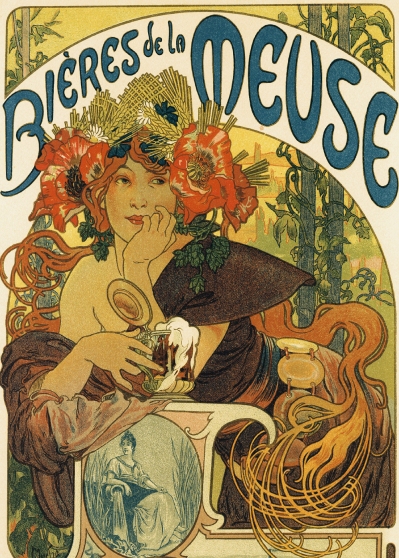
Left: Gustav Stickley; Right: William Morris.
During the latter half of the 19th century, the arts and crafts movement developed in response to the growing industrialization of fine art production. Introduction of factories to English and American society made it possible to produce more art products faster and at a lower cost than a traditional hands-on craftsmen was able. The role of the craftsman had diminished from a creator of unique pieces to over-worked assembler of cheap copies. The movement shunned the mass production and mindless consumerism created by factories and praised calculated quality crafting and true artistic enjoyment by the dedicated individual. The ideal Arts and Crafts society would create factory-free designs that transformed the mundane surroundings of everyday, working people into beautiful, meaningful art. Although the movement ideally wanted to improve the lives of the working class people and free the craftsmen stuck in cruel factory settings, impractical high standards of hand-craftsmanship held the movement back from reaching out to less privileged people.

William Morris Sussex chairs and wallpaper designs: lavish details, expensively priced.
The interior designer William Morris was an Arts and Crafts movement supporter who put hand-craftsmanship at the upmost importance. Morris abandoned industrial production completely, calling factories “dark satanic mills”. His small collaborative interior design firm produced hand-made designs without the aid of mass production technology and without the influence of the salesman or advertiser. The artists in his firm full creative control over their craft, resulting in intricate decorative pieces that were no longer restricted by a factory drive to lower production costs. Although the furniture designs were unique and beautiful, the strict dissention away from factory technology increased the selling prices, created an exclusive market accessible only to the wealthy. The exorbitant adherence to pure hand-craftsmanship and anti-industrialization that manifested in Morris’ firm ended up causing his execution of the Arts and Crafts movement to fail the working class. While the factory setting may have “tainted” the relationship between skilled craftsman and unique art, it also made art affordable and available to a larger range of socio-economic classes. Morris’s total rejection of industrial innovations was a luxury only the privileged could afford to participate in, and did absolutely nothing to improve the lives of those that were still being affected by industrial mass production culture.

Stickley desk design: quality construction, functional and affordable.
Gustav Stickley was another furniture maker who subscribed to some of the ideas of the Arts and Crafts movement. In contrast to Morris, his willingness to compromise some of the more impractical purist ideals of the movement helped make his crafted art more widely available. Stickley, an admirer of Morris, also believed the factory era furniture production was inhumane to the workers, and that the pieces produced this way were devoid of quality. Instead of hand crafting every single piece, like Morris, Stickley increased efficiency by utilizing factory methods for producing basic furniture components. He integrated the movement’s need for hands-on involvement by hiring skilled craftsmen to carefully assemble the components and add decorative details by hand. This hybrid method saved the craftsman from wasted effort on menial processes, while still allowing for a meaningful relationship between craftsman and craft. Because of the cost-cutting use of limited factory methods, every day people could actually afford Stickley’s high-quality, hand crafted furniture. Stickley started a new trend in the factory production culture that improved the lives of many working class people, by treating his workers to an enjoyable working environment and emphasizing quality construction over quantity. Even today, the quality and superior craft of his furniture has stood the test of time, and what was once an affordable investment now sells online to collectors for thousands.
While Morris sold his art for a select few, and Stickley was able to sell his art for many, both artists placed an emphasis on hand-crafted quality. It is ironic that in the pursuit of creating unique work, the artists’ designs have been copied over and over by furniture companies throughout the last century. What is great is that many of these designs are available online for people to execute themselves, so while the uniqueness has been compromised, the designers have certainly influenced many to see the value of creating by hand over buying cheap mass produced products.
References:
Jirousek, Charlotte. “The Arts and Crafts Movement.” The Arts and Crafts Movement. N.p., n.d. Web. 26 Sept. 2016. <http://www.char.txa.cornell.edu/art/decart/artcraft/artcraft.htm>.
Eskilson, Stephen. Graphic Design: A New History. New Haven, CT: Yale UP, 2012. Print.
“Arts and Crafts Movement.” Encyclopedia Britannica Online. Encyclopedia Britannica, 23 Feb. 2016. Web. 26 Sept. 2016. <https://www.britannica.com/art/Arts-and-Crafts-movement>.
Cathers, David. “The Stickley Museum at Craftsman Farms :: Stickley and A&C.” The Stickley Museum at Craftsman Farms :: Stickley and A&C. The Stickley Museum, 29 Sept. 2016. Web. 26 Sept. 2016. <http://stickleymuseum.org/learn-more/stickley-and-aac.html>.
(I tried really hard to indent each reference after the first line, but this website just won’t let me indent one line without indenting them all. I am so sorry.)






